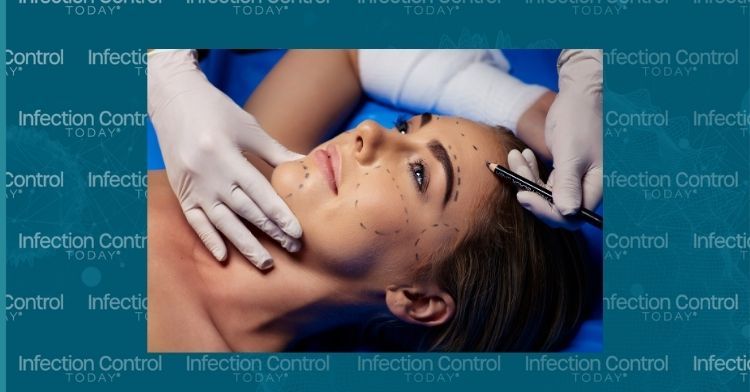Infection Prevention Protocols in Facelift Surgery: Expert Insights
Unlock the secrets to infection prevention in facelift surgery as renowned surgeons Dr. Konstantin Vasyukevic and Dr. Peter Lee share their expert insights and meticulous protocols in this informative interview.
Woman lying down with lines written on her face prior to plastic surgery.
(Adobe Stock 87953671 by Photo-maxx)

Infection prevention plays a paramount role in all health care settings, including plastic surgery, often an unexpected but vital domain in safeguarding patient health. In an exclusive interview with 2 renowned surgeons, Konstantin Vasyukevic, MD, and Peter Lee, MD, FACS, Wave Plastic Surgery, we delve into their meticulous infection prevention protocols during facelift procedures. The surgeons share their comprehensive strategies for minimizing infection risks, from prophylactic antibiotics to maintaining strict sterility.
ICT: What specific infection prevention protocols and measures are in place in your surgical facility to minimize the risk of infections during facelift procedures?
Konstantin Vasyukevic, MD: We use strict sterile techniques during the surgery and prescribe prophylactic antibiotics for the postoperative period.
Peter Lee, MD, FACS: For our facelift procedures, we ensure our patients receive 1 dose of intravenous antibiotics before surgery and an additional dose in the PACU before being discharged. During the procedure, the operative field is thoroughly irrigated with an antibiotic solution at regular intervals, and rigorous protocols for sterility are followed at every stage of the surgery.
However, the ultimate safeguard against infection is the intraoperative techniques we have developed over time to minimize this risk. The risk of infection rises dramatically when blood supply to tissues is compromised. With this in mind, we perform our dissections in a manner that preserves blood supply to flaps as much as possible. Excessive tension on tissues can also compromise blood supply and, therefore, put tissues at risk for infection.
Our facelift procedure is deliberately designed to minimize tension on tissues while still providing a powerful elevation of the soft tissues of the face and neck, thus reducing the risk of postoperative infection. Collections of blood beneath the skin and soft tissues also put patients at risk of infection. For this reason, the patient’s blood pressure is carefully controlled throughout the procedure, and rigorous hemostasis under magnification is serially performed throughout the procedure. We routinely place multiple drains at the end of the procedure to further reduce the chance that blood might collect in the surgical wounds in the acute postoperative period.
In addition, the surgery is performed in an outpatient surgery center that AAASF and Medicare accredit. Our surgery centers are only used for aesthetic surgery and, therefore, are not exposed to potentially more serious bacteria than some operating rooms may when dealing with sicker patients, such as in the hospital. Our surgery center also meets the most up-to-date technologies to reduce the infection rate, such as ultraviolet light cleansing of the operating room. All these maneuvers and techniques, in concert, dramatically reduce our patients’ risk of infection during our facelift procedures.
ICT: How do you ensure that your surgical team adheres to strict sterile techniques during surgery?
KV:My surgical team has received extensive training in sterile surgical techniques.
PL: The surgical team for our facelift procedures has been carefully trained over many years to create and maintain an environment of strict sterility in the operating room during our surgeries. We conduct regular in-service training, reviews, and updates of the latest protocols and techniques for achieving rigorous sterility and infection control in our operating rooms.
ICT: How do you maintain a controlled and sanitary surgical environment?
KV: We adhere to a strict protocol of cleaning, sterilization, and disinfection.
PL: We have all our surgical and anesthesia equipment regularly inspected and replaced with the latest technology as it becomes available. All surgical instruments are sterilized in our state-of-the-art autoclaves, and each tray of instruments is checked and double-checked to ensure that sterilization is complete. In addition to undergoing daily cleaning, our operating rooms undergo complete terminal cleaning from floor to ceiling at regular, frequent intervals.
ICT: What types of facial surgeries do you specialize in?
KV: I am an expert in Facelift and facial rejuvenation.
PL: We have a holistic and integrative approach to pan-facial rejuvenation to ensure that our facial procedures achieve a balanced and natural rejuvenation of the face and neck. To achieve this end, we have developed and honed our techniques in
- endoscopic browlift
- endoscopic facelift
- extended SMAS facelift
- upper blepharoplasties, with or without ptosis repair, lateral canthopexy, lateral canthoplasty, and medial epicanthocanthoplasty
- lower blepharoplasty with an anteroseptal, retroseptal, or transconjunctival approach, with or without arcus marginalis release and fat transfer or fat transposition to the tear trough
- open and closed rhinoplasty with or without nasal implant or rib and conchal cartilage grafting
- chin implant placement via an intraoral or external approach
- open and closed neck lifts
- liposuction and Facetite treatments of the skin and soft tissues of the face and neck
- fat transfer to the face
- mandibular reduction.
ICT: Do you routinely prescribe antibiotics to patients before facelift surgery as a preventive measure against postoperative infections?
KV: Yes. Every patient receives a prescription for postoperative antibiotics.
Uncovering a Hidden Risk: Alcohol Use Disorder Significantly Increases C difficile Infection Rates
April 10th 2025A groundbreaking study reveals a strong connection between alcohol use disorder and increased risk for Clostridioides difficile infection, challenging traditional assumptions and calling for enhanced infection prevention protocols.
Bridging the Gap: Operating Room and Central Processing Unite to Improve Surgical Efficiency
April 8th 2025Communication breakdowns between the operating room and central processing led to delays and frustration—until collaboration, cross-training, and shared goals turned metrics around and strengthened teamwork.